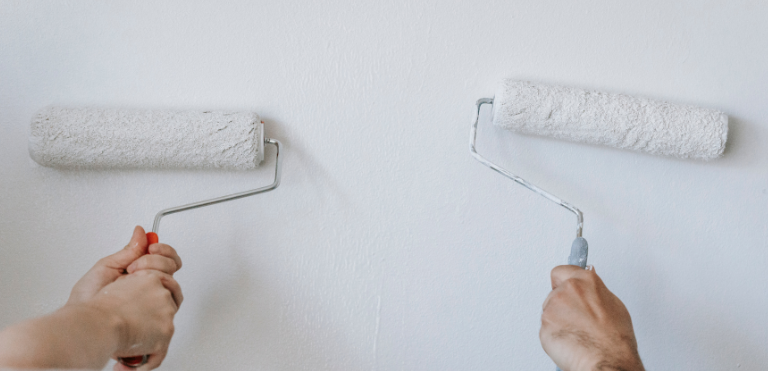How to Budget for a Home Painting or Flooring Project
Renovating your home with new paint or flooring can make a big impact on its look and feel, but it’s essential to have a budget in place to avoid surprises along the way. With careful planning, you can achieve the results you want without breaking the bank. Here’s a guide to help you budget for a painting or flooring project, so you can transform your space with confidence.

Paint & Plank can help find the best pro with the best deal!
Step 1: Determine the Scope of Your Project
The first step in budgeting is to define the scope of your project. Decide which rooms or areas you want to paint or refloor, and take measurements of the square footage involved. For painting, consider whether you’re painting just the walls or if you’re also painting ceilings, doors, and trim. For flooring, determine whether you’re replacing flooring in multiple rooms or just a single space.
- Why it matters: Defining the project scope allows you to understand the size and cost of the project, so you can calculate materials and labor accurately.
Step 2: Choose Your Materials
Next, consider the materials you’ll need for the project. For painting, the type of paint (e.g., matte, eggshell, gloss) and the brand can affect the cost significantly. For flooring, material options include hardwood, tile, vinyl, carpet, and laminate, each with its own price range.
Estimate for Painting: Higher-quality paints and specialty finishes, like mildew-resistant paint for bathrooms, tend to cost more. Calculate how many gallons of paint you’ll need based on your square footage.
Estimate for Flooring: Hardwood and tile are generally more expensive than laminate or vinyl, so consider your budget and desired look carefully.
Why it matters: The cost of materials can vary widely, so having a clear idea of what you want helps you stay within budget without compromising quality.
Step 3: Calculate Labor Costs
Labor is often one of the biggest expenses in a home improvement project. For painting, contractors typically charge per square foot or per hour. Flooring installation costs also vary depending on the complexity of the job and the material being used. You can save on labor by doing some of the prep work yourself, like clearing the room or removing old flooring or wall coverings.
Get Multiple Quotes: Contact a few contractors to get quotes based on the scope of your project. Ask about any additional fees for preparation work, such as wall repairs for painting or floor leveling for flooring.
Consider DIY for Small Projects: If your project is small and manageable, consider handling the painting or flooring yourself to save on labor costs.
Why it matters: Knowing labor costs upfront allows you to compare options and decide if professional help is necessary, helping you allocate your budget wisely.
Step 4: Factor in Preparation and Cleanup
Preparation work is often overlooked in budgeting but can add to the total cost. For painting, this includes cleaning and sanding walls, repairing holes or cracks, and applying primer. For flooring, it may include removing old flooring and leveling the subfloor. Don’t forget to budget for cleanup supplies or potential disposal fees for old flooring or paint cans.
- Why it matters: Preparation and cleanup are essential steps that impact the quality and longevity of the final result. Including them in your budget prevents any surprises later on.
Step 5: Set Aside a Contingency Fund
Unexpected issues can arise during any home improvement project, so it’s a good idea to set aside an extra 10-15% of your total budget as a contingency fund. This can cover unforeseen costs like additional wall repairs, discovering subfloor damage, or needing more materials than originally estimated.
- Why it matters: A contingency fund provides peace of mind, ensuring that you won’t go over budget if surprises arise along the way.
Step 6: Decide on Additional Finishing Touches
If you want a truly finished look, consider adding some finishing touches. For painting, this might mean adding new hardware, switch covers, or molding. For flooring, it could include installing new baseboards, trim, or area rugs to complement the space. These additional touches may add to your budget, so decide which elements are worth the investment.
- Why it matters: Finishing touches make a big difference in the overall aesthetic of the room and can give it a polished, high-quality look.
Step 7: Compare Your Budget to Your Desired Outcome
Once you’ve calculated material, labor, preparation, and contingency costs, compare your total budget to your desired outcome. If the total exceeds what you want to spend, consider areas where you can adjust. For example, choosing a less expensive paint brand or opting for laminate instead of hardwood flooring can help bring the project within budget without sacrificing too much on quality.
- Why it matters: Staying within budget helps you achieve a satisfying result without financial stress, ensuring you can enjoy your updated space without worries.
Final Thoughts
Budgeting for a home painting or flooring project doesn’t have to be overwhelming. By taking the time to define the project scope, research material and labor costs, and set aside a contingency fund, you’re setting yourself up for success. With a well-planned budget, you can create a space that’s stylish, functional, and affordable, adding value to your home and enjoyment to your everyday life.
Let us know if you need help finding trusted contractors or estimating costs for your next home project!
